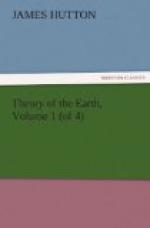The port of Syracuse, with the island which forms the greater and lesser, and the fountain of Arethusa, the water of which the ancients divided from the sea with a wall, do not seem to be altered. From Sicily to the coast of Egypt, there is an uninterrupted course of sea for a thousand miles; consequently, the wind, in such a stretch of sea, should bring powerful waves against those coasts: But, on this coast of Egypt, we find the rock on which was formerly built the famous tower of Pharos; and also, at the eastern extremity of the port Eunoste, the sea-bath, cut in the solid rock upon the shore. Both those rocks, buffeted immediately with the waves of the Mediterranean sea, are, to all appearance, the same at this day as they were in ancient times.[19]
[Note 19: Lettres sur l’Egypte, M. Savary.]
Many other such proofs will certainly occur, where the different parts of those coasts are examined by people of observation and intelligence. But it is enough for our present purpose, that this decrease of the coasts in general has not been observed; and that it is as generally thought, that the land is gaining upon the sea, as that the sea is gaining upon the land.
To sum up the argument, we are certain, that all the coasts of the present continents are wasted by the sea, and constantly wearing away upon the whole; but this operation is so extremely slow, that we cannot find a measure of the quantity in order to form an estimate: Therefore, the present continents of the earth, which we consider as in a state of perfection, would, in the natural operations of the globe, require a time indefinite for their destruction.
But, in order to produce the present continents, the destruction of a former vegetable world was necessary; consequently, the production of our present continents must have required a time which is indefinite. In like manner, if the former continents were of the same nature as the present, it must have required another space of time, which also is indefinite, before they had come to their perfection as a vegetable world.
We have been representing the system of this earth as proceeding with a certain regularity, which is not perhaps in nature, but which is necessary for our clear conception of the system of nature. The system of nature is certainly in rule, although we may not know every circumstance of its regulation. We are under a necessity, therefore, of making regular suppositions, in order to come at certain conclusions which may be compared with the present state of things.
It is not necessary that the present land should be worn away and wasted, exactly in proportion as new land shall appear; or, conversely, that an equal proportion of new land should always be produced as the old is made to disappear. It is only required, that at all times, there should be a just proportion of land and water upon the surface of the globe, for the purpose of a habitable world.




